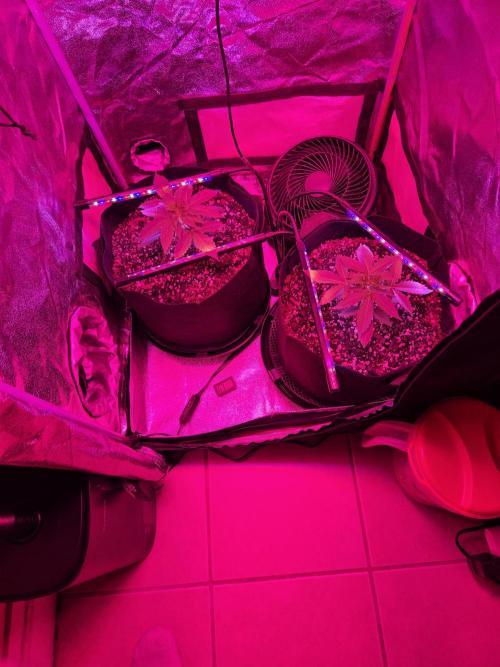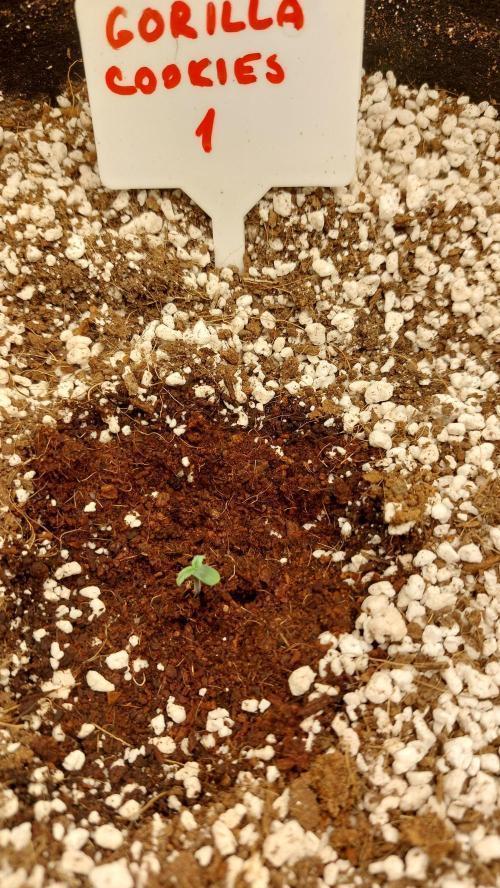The Grow Awards 2026 🏆 





















Should I cut the bucket down to give airflow and a...
Aleatoricstarted grow question 2y ago
Should I cut the bucket down to give airflow and access to the side of the plant? Doesn't look like it wants to poke up, and I wish I had the foresight to add more material before planting, but I was assuming the plant would be taller by now.
likes
Answer
Organomananswered grow question 2y ago
No don't worry, everything will turn out fine.
But yes, always fill your containers right up to the top!
likes
Complain
Incognitusanswered grow question 2y ago
and, lol i thought it was some translation error.. no i wouldn't cut the bucket down.. if you have some air currents, it'll be fine. remove any leaves pointing down into substrate..
if you really wanted to, once it's taller you can add an inch or two of substrate if you wish.. i wouldn't bother though. When you transplant, before you bury anything, place the put into the hole you dug... is it at the right level? if not dig some more or fill it in a bit to get it to the right level. i try to get a layer on top of the transplant. if you ahd good watering habits, you shouldn't have any superficial roots, so removing a 1/2" off the top of a transplant isn't too big of a deal either -- one more tool to level it out the way you want.
When i transplant a larger plant in a 1gallon (vs seedling pot), i dig a partial hole with a slgihtyl udnerfilled pot. this way i can level it out and work the substrate around it to hold it steady exactly where i want it - e.g. if tilted i gently lift it and push some substrate under or pack in one side to hold it more vertically. Once sufficiently positions, then pour in some from sides to fill in the rest... hold the leaves up with one hand and dump it in, then level it out. Jst work your way around. this part doesn't take much ... dump and level. I do one half then the other. Make sure if anything is not even it is concave and not convest.. between the two options - water you put on top rolling (gravity/slope) toward center is better than toward the edges. It makes watering more of a pain to ensure no dry pocklets if ther's a slope or uneven top... the low side will sink in faster / gravity will pull it that way as you water the top... i have a sloped platform.. i slightly favor the high side with my drippers for this reason.
1 like
Complain
Incognitusanswered grow question 2y ago
It doesn't look like the nodes are too tight. slow growth could be from genetics or the substrate if not the best... even the balance of nutes -- though in regard to nutes they look fine... probably just a bushy, short plant.
1 like
Complain
Incognitusanswered grow question 2y ago
In that situation, i sometimes remove leaves pointing inward if they are all bunched up.. try to alternate what you remove so that 1 limb doesn't take more damage than the rest.
if you have an idea on how large you want the plant to be, these early nodes may not even be important or used later on... in those cases i might prun them off or strip lower axillary buds (leaving the leaves as much as possible). if it is unused growth later on, no harm removing it now. Try to retain as many leaves as possible, though.
my threshold for removing a leaf is if it's all controted and unhealthy looking. They go downhill in that context.. slowly pale and shed by plant. Contorted leaves are trying way too hard to find light or breathing room. Shielded leaves are still a net positive for the plant, however. they still store necessary building blocks. They still bring in CO2, the limiting factor for growth in most gardens. A useless axillary branch is a sinkhole for resources, but leaves are useful almost always as long as not physically bunched up beyond reason.
If your node spacing is very tight, try reducing light intensity a bit and see what happens over enough time. If it is stunted at all, the longer it's been stunted the longer it takes to snap out of it. Minor stretch early on is not too big of a deal. It helps spread the plant out and avoid this situation.
Have an end goal for your plant as far as area of growth and number of colas. Work backward from there to form a plant to shape the plant in the most efficient way to get there. Doing so gives clarity on what is needed growth and resource wasting branches that'll never be used. This isn't fool-proof, and soemtimes you leave excess when unsure or need clones... i recently stripped all my lower nodes as they got large enough to pluck, forgetting i needed to take cuttings before flower phase, LOL... looks like i'm taking cuts in flower, oops. Point is.. have a plant. think it through. Only cut off what is not needed. Have a good reason to remove leaves, if you do. A little trial and error to find out where that threshold is and to gain familiarity is a rite of passage.
1 like
Complain
Similar Grow Questions
Solved

Butcheebudz
First grow issuesHi all,
I’m new to growing and have had a little issue with one of the plants stop growing after one week but still taking small amounts of feed.
Please have a look through my diary and any tips or pointers would be appreciated greatly.
Week 2
Plant. Too short
5y ago
4
2
Solved

BreadmanDan
Height questionsI am curious about why my plants just don’t seem as tall as others that I see. Overall I think it looks healthy just not as tall as I would like. How high should my light be?? Currently running a Mars hydro tsw2000.
Was also thinking of switching to flowering. Thoughts??
Week 7
Plant. Too short
4y ago
1
3
Solved

Sam_The_Herborist
Why my plants are so slowI have 2 GG auto and they are pretty slow to grow comparing with the other diary that I can see on the website
I'm noob in cultivation and I'm pretty close to give up because I fuck up everything all the time
So I want to know the reason to make the grow great again
Thanks you5y ago
2
2
Solved

di_berlin
plant seems at a standstill - very little gain in size and new growth - how come?they were put into bigger pots 2 weeks ago.
hardly any new growth and gain in size. one in very bad shape, other developing hairs nicely.
both stay almost same I size and no new leaves.
I was expecting them to stretch now in week 6.
what to do apart from watch and be patient?
Week 5
Plant. Too short
6y ago
1
1
Solved

purgen
Need tips/help with very very bushy plantPotted for almost 6 weeks, grows super super bushy (already has 12 branches (6 nodes?), branches are so short that I can't even LST them. I guess she grows like that because of her genetics but maybe there's a way how to 'fix' her? Topped once, strain RQS Triple G
Plant. Too short
Techniques. LST
3y ago
4
Solved

ProfessorNusters811
Hi all! 31 day old first grow Auto amnesia. Started in these big pots maybe bad idea? 30cm wide pots.How do u guys think? All criticism and advice welcome!First grow, seedsman Auto amnesia 18/6 with Coco feed a+b 5.8ph water. This is my first ever grow and a lot of time needed to learn but wondering how people think? Do they look behind? Healthy? One got stunted/ upped the a+b too soon. Now other has some slight browning in newtips
Plant. Too short
6y ago
3
4
Solved

versace_grow
Ok... this is strange!This is not good. I have a baby plant which is having real trouble growing. It has just cothyledons out in 15 days! This is not normal. Have you ever experienced something similar?
Leaves. Too few
Plant. Too short
Setup. Outdoor
6y ago
1
1
Solved

MrJones
Anyone growing or grown FB Pineapple Express do my plants look like they are on track, I feel they are not, at only 12/14 inches at the 35-day mark - would like to hear from
@Fast_Buds as well, I am growing organically no chemical nutrients here - thoughts?
Week 5
Plant. Too short
6y ago
3
3
Solved

heythere12345
General looksHow are my blackberry auto and orange sherbet look like in general? Orange sherbet stayed too short for some reason.. feeding schedule is the same on both( see blackberry auto diary).😁
Leaves. Color - Dark-brown
Plant. Too short
4y ago
2
3
Solved

Newgrow25
clip Led?Have a short plant, can I add clip led lights to get light to the base of my plant??
Plant. Too short
Setup. Lighting
Feeding. Other
2mo ago
1
3
Solved

Kreewl
Más o menos potencia?Trabajo con dos paneles led de 200w cada uno, y tienen regulador de potencia. Como creéis que debería usarlos en todas sus fases de cultivo?por ejemplo, al principio los pongo a 40cm y mitad de potencia, luego a 80cm y al máximo?creo que no tengo un crecimiento adecuado por algo.Week 5
Plant. Too short
6y ago
3
2
Solved

Danbibiqn
Hello guys, this girl is about 30 days old now and she is bit small because i had troubles at the beginning with overwatering and other issues.She is blueberry auto haze i am wondering if there is still chance to get some yeild from her or just to start over again?
Plant. Too short
4y ago
8
4


















